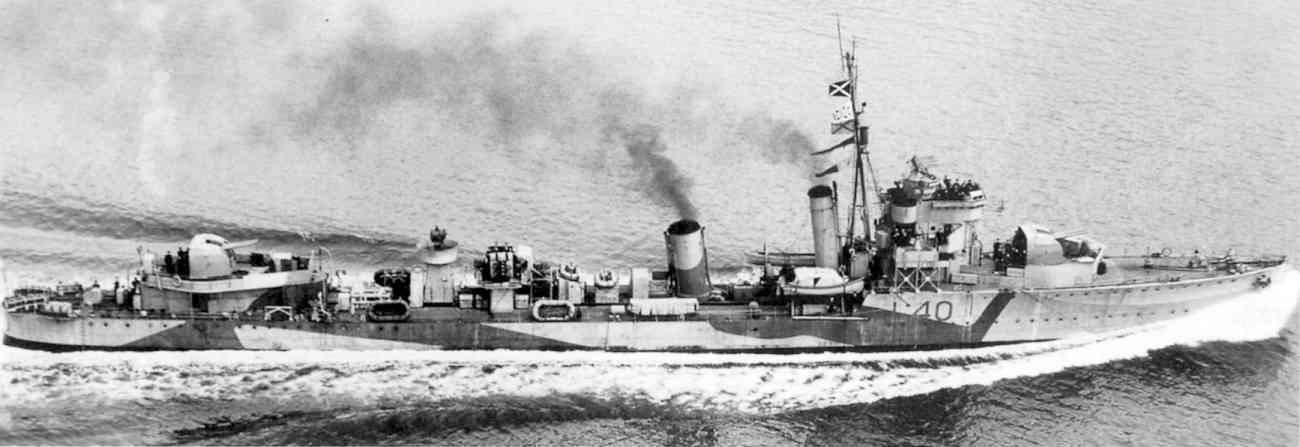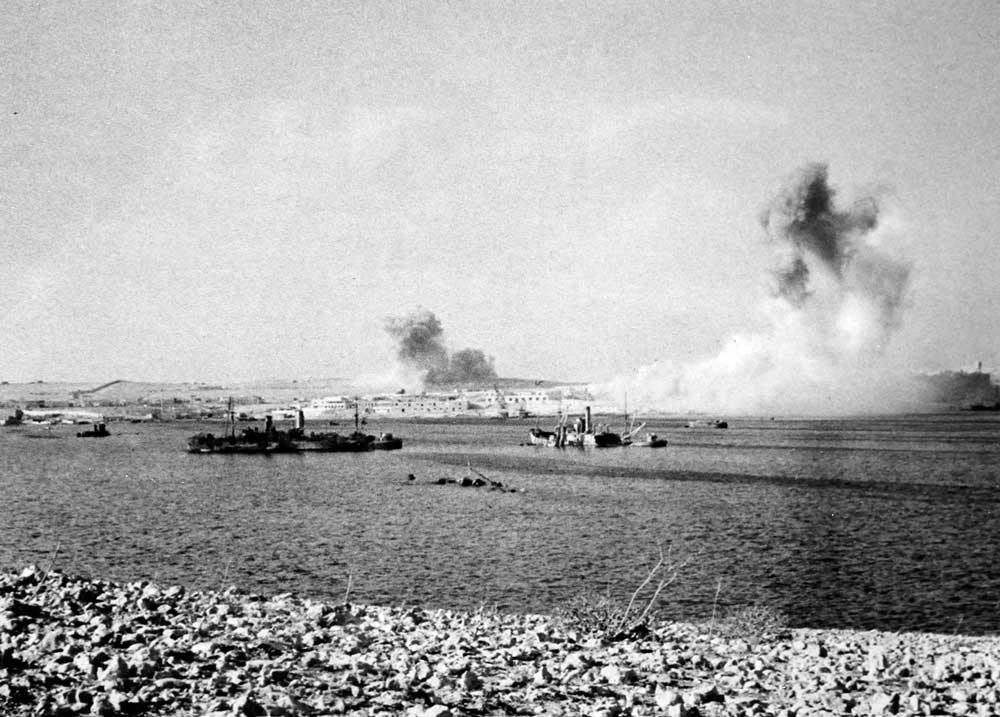December 2016
However, the maintenance of the siege would not have been possible if it had not been for the Inshore Squadron, that curious fleet of ships and craft that kept the besieged garrison supplied with everything they needed to hold out for all that time. A fleet of ships ranging from former British India small liners, ex China Station gunboats, South African Navy armed whalers, Canadian minesweepers, tank landing craft, water and petrol carriers, bulk traders and even some sailing vessels like the ketch Zingarella and the captured schooner Maria Giovanni, supplemented quite often with fast minelayers, destroyers and frigates when these could be spared from other operations.
Supplies were usually loaded in the Egyptian ports of Alexandria and Mersah Matruh and, because of lack of air cover, many passages in and out of Tobruk had to be done at night which meant that unloading and back- loading had to be done very quickly and this in a port which daily became more cluttered with vessels that had been sunk by enemy air attacks.
Prominent among the warships supplementing the Inshore Squadron was the ‘Scrap Iron Flotilla’, the Royal Australian Navy’s World War 1 destroyers commanded by Captain H. Waller in HMAS Stuart, with HMAS Vampire (Lieutenant Commander J. Walsh) HMAS Vendetta (Lieutenant Commander R. Rhoades) HMAS Voyager (Lieutenant Commander J. Morrow) and HMAS Waterhen (Lieutenant Commander J. Swain). They were also joined by the N Class Destroyers HMAS Napier (Captain S. Arliss, RN) and HMAS Nizam (Lieutenant Commander M. Clark) and the Grimsby Class sloops HMAS Parramatta (Lieutenant Commander J. Walker) and HMAS Yarra (Lieutenant Commander W. Harrington – a future Chief of Naval Staff). The name “Scrap Iron Flotilla” was given to them by the Nazi Propaganda Minister Goebbels because they were so old. The Nazis also described the troops as being “caught like rats in a trap” hence they proudly became The Rats of Tobruk.
Of these ships HMAS Waterhen was sunk on 30 June following being hit by dive bombers and HMAS Parramatta was torpedoed by a U-boat off Tobruk on 27 November. The Australian ships were credited with doing 139 runs into Tobruk. HMAS Vendetta was the last of the Scrap Iron Flotilla to leave in October having done 39 trips, more than any other ship.

The ships usually worked in pairs and a typical run would be as follows:
- Day 1 Berth at night alongside at Alexandria, load 40 tons of 3.7 inch ammunition, land mines, 25 pounder ammunition, sacks of potatoes and onions, cases of dry provisions, mail etc all stowed on deck.
- Day 1 0700 Embark 100 personnel
0800 Sail for Tobruk Moderate speed until
1500 Increase to 25 knots
2000 (dusk) Increase to 28 knots
2300 Arrive Tobruk, slow in through channel and boom
Anchor or berth on wreck or oiling jetty + Discharge stores and men into lighters, tugs etc Embark wounded and men relieved (if any)
- Day 2 0100 Sail – slow out then as fast as slowest ship allowed
- 0500 Daylight – rendezvous with fighters
0900 Arrive Mersah Matruh – disembark wounded etc p.m. Embark stores
- Day 3 1330 Sail for Tobruk – as for Day 1
- Day 4 Return to Alexandria arriving about 1400
+ Oil fuel could be supplied from ex-Italian shore tanks, gravity fed at 30-50 tons per hour
On Days 2 and 4 other pairs of destroyers would make the trip and so rotation would go on.
The slower tank landing craft and other small ships were usually sailed to arrive just after dawn. During the day it was tried to hide them using camouflage nets berthed alongside rocks or wrecks in the harbour. They usually remained two nights and, if possible, were back-loaded with damaged tanks or other valuable vehicles for repair. A difficulty with night off-loading was ensuring the right stores got to the right destination. When, after a request from Lieutenant General Morshead, the Tobruk Fortress Commander, some luxuries began to arrive a careful watch was essential. A bottle of whisky or a case of beer could disappear very quickly!
In early August it was decided to pull the Australian troops out of Tobruk and replace them with Polish and British elements. Again most of this was done by warships and at night. All went well until 25 October when the fast minelayer HMS Latona was bombed and sunk on passage to Tobruk. This meant that the evacuation had to be abandoned and the 2/13th Battalion and some other Australian troops had to remain in Tobruk until the siege was lifted.
The movements in and out of Tobruk during the siege were as follows:
The ships delivered 72 tanks, 92 guns, 33,946 tons of stores, ammunition, food and fresh water and 108 live sheep (food for the Indian troops). 32,667 troops were evacuated and were replaced by 34,113 fresh troops. 7,516 wounded men were transported to base hospitals and 7,097 captured prisoners were taken to the rear. 27 Naval ships were sunk and 27 damaged. 7 Merchant ships were sunk and 6 damaged. The casualties were Naval personnel killed or missing 469, wounded 186 and Merchant Service killed or missing 70, wounded 55.
(Source: C-in-C Med’s signal to Admiralty 760 dated 12/12/41)

A few days after the siege was lifted Admiral Sir Andrew Cunningham, Commander-in-Chief, Mediterranean issued this Special Message.
“Eight months ago the enemy isolated the fortress of Tobruk and laid siege to it. Today Tobruk is no longer besieged and her garrison is pursuing the retreating enemy to the westward. During those fateful eight months the task of maintaining the garrison with all its bodily needs and war supplies has fallen on the Navy and units of the Merchant Navy. Most of the work devolved on destroyers and small ships.Units from the Royal Navy, the Royal Australian Navy, and Indian Navies and the naval forces of the Union of South Africa all took their part whilst amongst the crews of the merchant ships were officers and men of the Allied Nations. When the tale of the siege of Tobruk comes to be written, the part played by these craft will provide a story worthy of the highest traditions of our naval history. I have watched with admiration the work of the “little ships”. They have borne the burden of the day but neither fatigue nor the assaults of the enemy have deterred them. Their achievement is one of which they may all be proud.”
Alexandria (sgd) A.B. CUNNINGHAM
19 December Admiral
During siege of TOBRUK between 12th April and 10th December, 1941:
(1) Following were moved by sea:
Personnel in 32667
Personnel out 34113
Wounded out 7516
Prisoners-of-war out 7097
Stores in 33,946 tons.
Tanks in 72
Guns in 92
Sheep in 108
(2) The following casualties were sustained:
- (a) M. ships sunk:
Destroyers 2
Sloops 3
A/S and M/S vessels 7
“A” lighters 6
H.M. store-carriers
and schooners 7
Gunboats 1
Fast Minelayers __1__
Total: __27__
- (b) H.M. Ships damaged:
Destroyers 7
Sloops 1
A/S & M/S ships 11
“A” lighters 3
Gunboats 3
Schooner 1
and H.M.S. “GLENROY” ____
Total: _27_
- (c) Merchant-ships sunk 6 and 1 schooner
- (d) Merchant-ships damaged 6
- (e) Naval casualties
killed or missing 459
wounded 186
- (f) Merchant Service
killed or missing 70
wounded 55
=1829B/11
THIS DOCUMENT WAS FOUND IN LIEUTENANT GENERAL LESLIE MORSHEAD’S ARCHIVE IN THE AUSTRALIAN WAR MEMORIAL, CANBERRA
FOR INFORMATION
The following ships will sail as indicated:-
FOR MATRUH : SATURDAY 21 JUNE 41 (about 0100/22)
H.M.A.S. ‘STUART’ from Harbour anchorage
H.M.A.S. ‘VOYAGER’ from Oiling Jetty
Intending passengers by above vessels should assemble at ‘TOBRUCH Steamship Company’ offices (ADMIRALTY HOUSE), NOT later than 2300/21 for final instructions and internal inoculation ‘Mae Westers’ will be supplied on board. All precautions taken but personal safety not guaranteed.
In the event of the shipmaster hazarding, stranding or inadvertently losing his vessel, well, IT’S JUST TOO BAD!!
SAILINGS FROM MATRUH FOR TOBRUCH
These are dependent entirely upon the whims of C-in-C and/or R.A.L.
1400 hrs MONDAY 23 JUNE
HMAS STUART (b) e). HMAS VOYAGER (a)(f)
1400 hrs TUESDAY 24 JUNE
HMAS WATERHEN (a) (x) HMAS VENDETTA (b) (y)
(a) will berth at Oiling Jetty, TOBRUCH
(b) will anchor off No. 5 Jetty, TOBRUCH
(x) Senior ship – plenty of booze
(y) Charming Captain, but a “long ship”
(e) Good “eats”, private bathroom, best cabin, ample booze
(f) “lashings” of booze.
MASTERS :
STUART Captain H.M.L. Waller, D.S .O., RA N
VOYAGER Commander J.C. Morrow, D.S.O., RAN
WATERHEN Lt Commander J. Swain
VENDATTA Lt Commander R. Rhoades, R.A.N.
